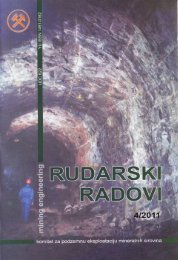Institut za rudarstvo i metalurgiju Bor
Institut za rudarstvo i metalurgiju Bor
Institut za rudarstvo i metalurgiju Bor
You also want an ePaper? Increase the reach of your titles
YUMPU automatically turns print PDFs into web optimized ePapers that Google loves.
PROTECTION IN THE MINE<br />
DESIGNING<br />
In any business, the design process<br />
should be carefully considered from the<br />
standpoint of environmental protection. In<br />
the mine designing for exploitation the oil<br />
shale, several items have to be taken into<br />
account:<br />
• to carry out the additional researches<br />
to environmental protection that will<br />
convince the local population to tolerate<br />
the exploitation impact of the<br />
same,<br />
• the mine have to be located, if possible,<br />
away from the settlements,<br />
• in the vicinity of settlements, the<br />
blasting works should not be used,<br />
• the mining works must not damage<br />
the certain aquifers in order to prevent<br />
the water contamination,<br />
• oil shale stocks, breaking and transport<br />
unit should preferably be located<br />
in the forest to prevent the spread of<br />
noise and dust,<br />
• barriers to noise and dust should also<br />
be located between the settlements<br />
and existence of mine . For such purposes<br />
it is even necessary to plant<br />
trees.<br />
Important requirements that need to be<br />
taken into account during designing are:<br />
- how negative environmental impacts<br />
be minimized?<br />
- is it possible to use selective or nonselective<br />
method of exploitation?<br />
- which method of exploitation guarantees<br />
determination of output results?<br />
- how to reduce the use of certain machines?<br />
- whether to buy or rent a machine? [2]<br />
SOIL POLLUTION IN THE<br />
EXPLOITATION<br />
Surface exploitation causes a lot of<br />
surface disorders of land and has a high<br />
impact on surface water, subsurface water,<br />
flora and fauna. Experiences in coal exploitation<br />
and other raw materials indicate<br />
that the impact on environment is very<br />
high but with minimum long-term effect.<br />
Underground exploitation causes<br />
much less surface disorders. Surface disorders<br />
are limited but include dust emissions<br />
caused by transport and storage.<br />
„In-situ” exploitation involves less<br />
mining works that are limited to drilling of<br />
so called thermal drill holes and production<br />
drill holes at a small distance. Impact<br />
on the environment will be similar to the<br />
production of gas and oil. Drill holes of<br />
this type of exploitation require security<br />
and sealing.<br />
Other surface effects in most case depend<br />
on construction of surface facilities,<br />
including equipment for retorting, upgrade,<br />
dumping and transportation. New pipelines,<br />
roads and related facilities, may also have<br />
an impact on surface contamination.<br />
Spent shale: surface retorts produce<br />
large quantities of processed or spent oil<br />
shale. Technology of retorting seeks to<br />
reduce the residual carbon, making the<br />
processed shale safer for the environment.<br />
Some spent shale could be used as a commercial<br />
material for construction or as a<br />
material for re-cultivation of the land.<br />
WATER POLLUTANTS<br />
At larger distance from the mining operations<br />
or facilities for retorting, the soil<br />
and ground water contamination appears.<br />
“In-situ” exploitation has high effect on<br />
the ground water quality. In these cases, a<br />
control and protection of surface and<br />
ground water sis required. The efficient<br />
technologies and process management<br />
have been demonstrated and shown in the<br />
other similar cases of commercial mining.<br />
No 1,2010. 142<br />
MINING ENGINEERING



